Related Research Articles
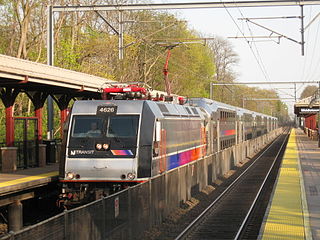
Commuter rail, or suburban rail, is a passenger rail transport service that primarily operates within a metropolitan area, connecting commuters to a central city from adjacent suburbs or commuter towns. Commuter rail systems are considered heavy rail, using electrified or diesel trains. Distance charges or zone pricing may be used.

Transport in Greece has undergone significant changes in the past two decades, vastly modernizing the country's infrastructure and transportation. Although ferry transport between islands remains the prominent method of transport between the nation's islands, improvements to the road infrastructure, rail, urban transport, and airports have all led to a vast improvement in transportation. These upgrades have played a key role in supporting Greece's economy, which in the past decade has come to rely heavily on the construction industry.

Light rail transit (LRT) is a form of passenger urban rail transit characterized by a combination of tram and rapid transit features. While its rolling stock is similar to a traditional tram, it operates at a higher capacity and speed, and often on an exclusive right-of-way. In many cities, light rail transit systems more closely resemble, and are therefore indistinguishable from, traditional underground or at-grade subways and heavy-rail metros.

The Athens Metro is a rapid-transit system in Greece which serves the Athens urban area. Line 1 opened as a single-track conventional steam railway in 1869 and was electrified in 1904. In 1991, Elliniko Metro S.A. constructed and extended Lines 2 and 3. It has significantly changed Athens by providing a much-needed solution to the city's traffic and air pollution problem, as well as revitalising many of the areas it serves. Extensions of existing lines are under development or tender, like the Line 2 extension to Ilion where tender started in 2023, as well as a new Line 4, whose central section began construction in October 2021. The Athens Metro is actively connected with the other means of public transport, such as buses, trolleys, the Athens Tram and the Athens Suburban Railway. The Athens Metro is hailed for its modernity, and many of its stations feature works of art, exhibitions and displays of the archaeological remains found during its construction. Photography and video-taking is permitted across the whole network and street photographers often work in Athens Metro. This will be the only metro system in Greece, until the Thessaloniki Metro begins operation in 2024.

Transport for Athens, officially the Athens Urban Transport Organisation, is the operator of public transport in Athens, Greece. Transport for Athens, through its subsidiary companies, operates metro, tram, trolleybus and bus services in the Athens metropolitan area. Municipal buses and the KTEL network being are main competitors to Transport for Athens.

An elevated railway or elevated train is a railway with the tracks above street level on a viaduct or other elevated structure. The railway may be broad-gauge, standard-gauge or narrow-gauge railway, light rail, monorail, or a suspension railway. Elevated railways are normally found in urban areas where there would otherwise be multiple level crossings. Usually, the tracks of elevated railways that run on steel viaducts can be seen from street level.

The Oslo Metro is the rapid transit system of Oslo, Norway, operated by Sporveien T-banen on contract from the transit authority Ruter. The network consists of five lines that all run through the city centre, with a total length of 85 kilometres (53 mi), serving 101 stations of which 17 are underground or indoors. In addition to serving 14 out of the 15 boroughs of Oslo, two lines run to Kolsås and Østerås, in the neighboring municipality of Bærum. In 2016, the system had an annual ridership of 118 million.
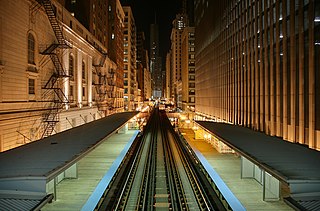
Urban rail transit is a wide term for various types of local rail systems providing passenger service within and around urban or suburban areas. The set of urban rail systems can be roughly subdivided into the following categories, which sometimes overlap because some systems or lines have aspects of multiple types.
Various terms are used for passenger railway lines and equipment; the usage of these terms differs substantially between areas:

Stadtbahn is a German word referring to various types of urban rail transport. One type of transport originated in the 19th century, firstly in Berlin and followed by Vienna, where rail routes were created that could be used independently from other traffic.

The Kryvyi Rih Metrotram, or the Kryvyi Rih Rapid Tram is a partially underground rapid transit light rail system that serves the city of Kryvyi Rih, the seventh-largest city in Ukraine.

A premetro is a tramway or light railway which includes segments built to rapid transit standards, generally as part of a process of conversion to a metro-standards railway usually by the construction of tunnels in the central city area.

A medium-capacity system (MCS), also known as light rapid transit or light metro, is a rail transport system with a capacity greater than light rail, but less than typical heavy-rail rapid transit. MCS's trains are usually 1–4 cars, or 1 light rail vehicle (LRV). Most medium-capacity rail systems are automated or use light rail type vehicles. Light rail is considered high capacity as trains use 2–4 LRVs.

The history of rapid transit began in London with the opening of the Metropolitan Railway, which is now part of the London Underground, in 1863. By World War I, electric underground railways were being used in Athens, Berlin, Boston, Buenos Aires, Budapest, Glasgow, Hamburg, Istanbul, Liverpool, New York City, Paris, and Philadelphia.
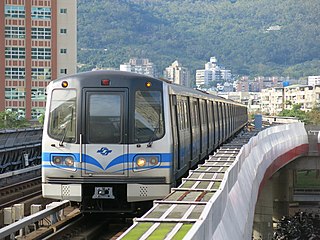
Rapid transit or mass rapid transit (MRT), also known as heavy rail or metro, is a type of high-capacity public transport that is generally built in urban areas. A rapid transit system that primarily or traditionally runs below the surface may be called a subway, tube, or underground. Unlike buses or trams, rapid transit systems are railways, usually electric, that operate on an exclusive right-of-way, which cannot be accessed by pedestrians or other vehicles. They are often grade-separated in tunnels or on elevated railways.

Urban rail transit in India plays an important role in intracity transportation in the major cities which are highly populated. It consists of rapid transit, suburban rail, monorail and tram systems. According to a report published in 2021, a total of 2.63 billion people travelled annually in metro systems across India's fifteen major cities, placing the country as one of the busiest urban rapid transit hubs in the world in terms of ridership. The combined length of 895 kilometres of metro systems in India makes it the third longest in operation in the world.
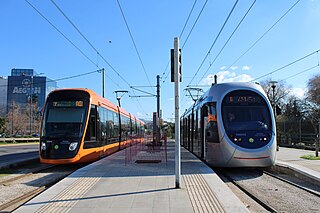
The Athens Tram is the modern public tram network system serving Athens, Greece. The system is owned and operated by STASY, which replaced Tram S.A. in June 2011.

High-floor describes the interior flooring of commuter vehicles primarily used in public transport such as trains, light rail cars and other rail vehicles, along with buses and trolleybuses. Interior floor height is generally measured above the street surface or above the top of the rail. High-floor designs usually result from packaging requirements: mechanical items such as axles, motors, crankshafts, and/or transmissions, or luggage storage spaces are traditionally placed under the interior floor of these vehicles. The term is used in contrast with low-floor designs, which offer a decreased floor and entry height above the street surface. Since low-floor designs generally were developed after high-floor vehicles, the older high-floor design is sometimes also known as conventional or the “traditional” design.
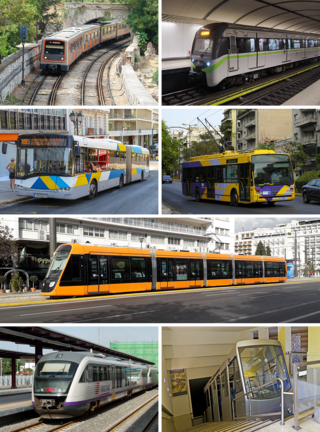
Public transport in Athens comprises a bus network, various rail systems, funiculars, and maritime services to serve the more than 4 million inhabitants of the city spread over an area of 2928 km2.
References
- ↑ "Rapid transit". Merriam-Webster . Retrieved 2008-02-27.; "Metro". International Association of Public Transport. Archived from the original on 2013-06-27. Retrieved 2008-02-27.
- ↑ "Glossary of Transit Terminology". American Public Transportation Association . Retrieved 2008-02-27.